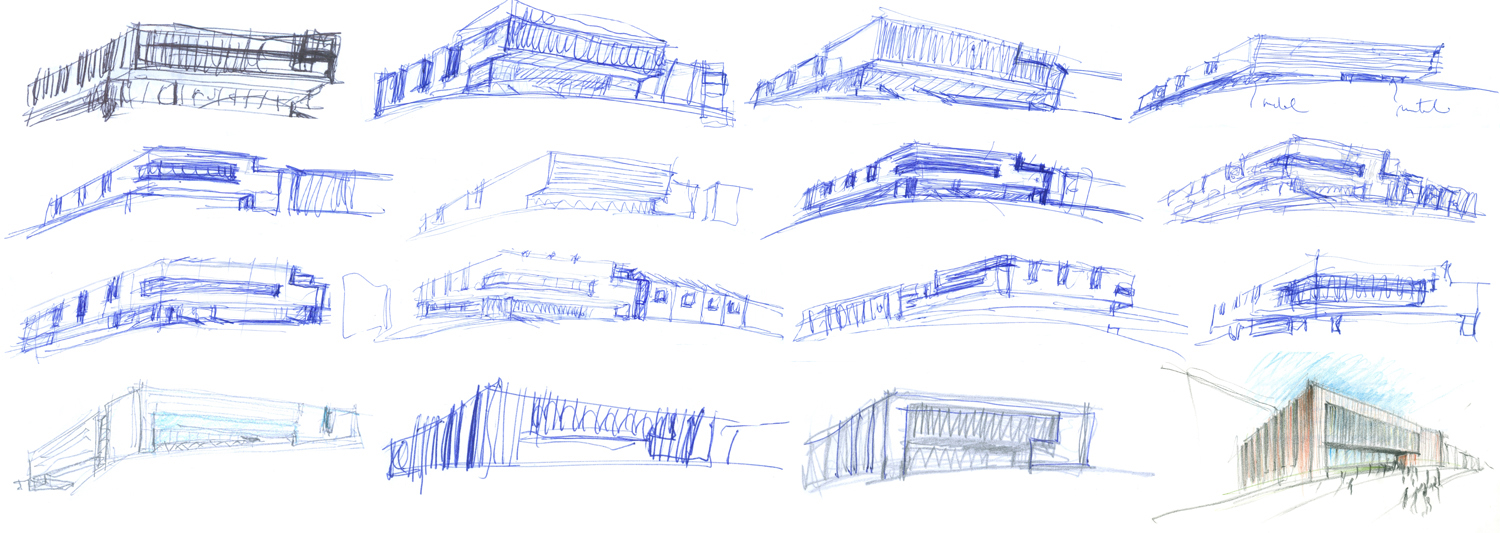We invested more time on drawing speculative drafts on perspective through the development of the project for University College of Osuna (Seville). 3D model sketches came one after another, without being a strict need for them. Some of them became almost identical, others led the way to dead-end streets (in most cases this was known beforehand). The result, a numerous series that could be read as an independent product from the final design, showed several vague perspectives aimed to look alike to those shining products from Siza.
However, if we follow the Portuguese master, “drawing sketches without making accurate drawings is useless”1 and, therefore, a series of sketches with kind of meaningful versions do not help to move forward within the design process, unless its verification is alternated with scale drawings. In that moment we realized without noticing it that we were painting just for pleasure. Hand drawing is becoming less poplar in Schools and drawing-boards, are we missing something?
The act of drawing may be pretty pleasant. Children use to draw just for pleasure, but it also exits the pleasure of practicing a trained skill, like those football players who can keep the ball always on air through touching it, just for fun. But, if we take a closer look, we could discover a bigger involvement from the nature of architectural creation and its relation with drawing. Some authors claim about the possibility of momentarily suturing (thanks to the act of drawing) the distinction between mind and body imposed by Western society, also replacing a predominance of vision for an integration of this sense among touch and with the body itself, letting a perception that closely shows our real experience with the world. Body and mind work together when drawing, exactly the same when you play an instrument.2
Abstraction as an exercise, a characteristic from human mind, is also pleasant. It provides understanding and coherence to our daily experience, despite of continuously showing it up as fragmented and vague. World becomes less weird and more comprehensible through abstraction.
Drawing connects ideas and material from the sensitive world. If we draw an already existent object, we make it comprehensible straight away but, if we draw something that do not exist, we get another type of satisfaction, this coming kind of satisfaction from making an object tangible from an abstract idea. Thus, creative painting is already architecture and the construction of the world, cosmopoiesis, a need deeply connected with human condition. A drawing provides proximity to the imagination, putting into work a bunch of faculties in a way no other mean could achieve.
Drawing is also investigation, testing. Is a question asked to the reality we face: “What if (things would be different…)?” Drawing, in a strict sense, is to start designing.
Among all those many materials shown at the compilation work for the career of RCR Office of Olot, also named “Share creativity” (on tour between 2015 and 2016)3, it was pretty revealing, in relation with the transcription of the ideas flow through drawing, the so called text “Screens”, where we could find the following words:
“Human mind, thanks to the activity of our brain, is screening every second and experts say that screening the imagination about a future object is the biggest human singularity. Those screenings, thoughts and ideas flow extremely fast. It is only possible to retain them when taking notes or making signals. If we would not do so, thoughts and screenings would fade, would not be retain, remember and would not become innto something more conscious. Screenings do not talk about mind complexities and they are essentially creative. (…) As a way of retaining those screenings, we should use every possible measure. (…) Spots, tracks, scribbles, signals, sketches, perfumes…everything is valid for our detention or transcription or transfer from immaterial, imaginative under materialization world.”
The daily life of our teaching or educational practice could make us each time (and without noticing it) more hostage of verbal communication or from simple transmission of not internalized visual images. Is a dangerous tendency: architecture does not show up while talking or writing or looking, but only exercising those owned actions, playing to build up a new world. The tool used for this play, the one making the mind, senses and mater work is still drawing. Architecture in a little version. In every one of its versions.
1 Cited in “Why Architects Draw”, Edward Robins. The MIT Press, Cambridge, MA, 1994.
2 It is necessary to acknoledge the importance of these words to these texts “The Death of Drawing. Architecture in the Age of Simulation”, de David Ross Scheer (Routledge, New York, 2014) y “The Thinking Hand. Existential and Embodied Wisdom in Architecture” de Juhani Pallasmaa (Willey &Sons, Ltd, Chichester, 2009)
3 An extremely well documented and carefully prepared exhibition shown in ICO Foundation Madrid during the first months of 2016


